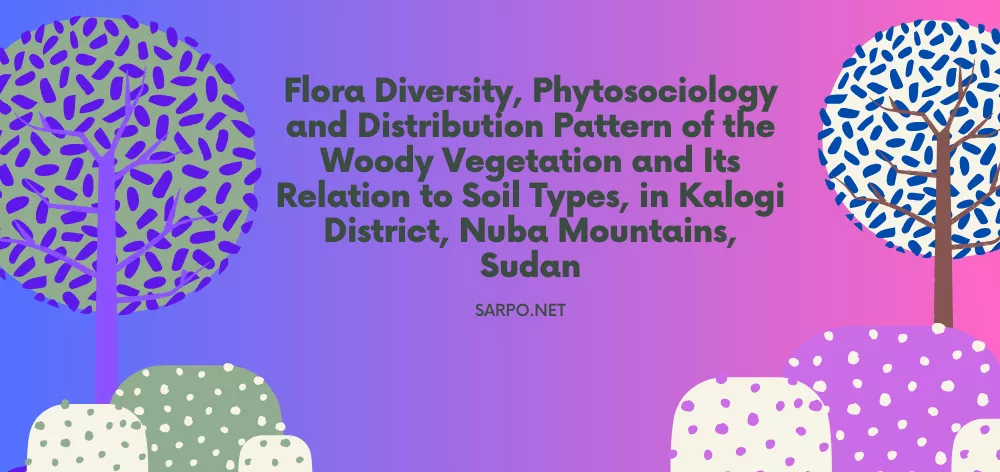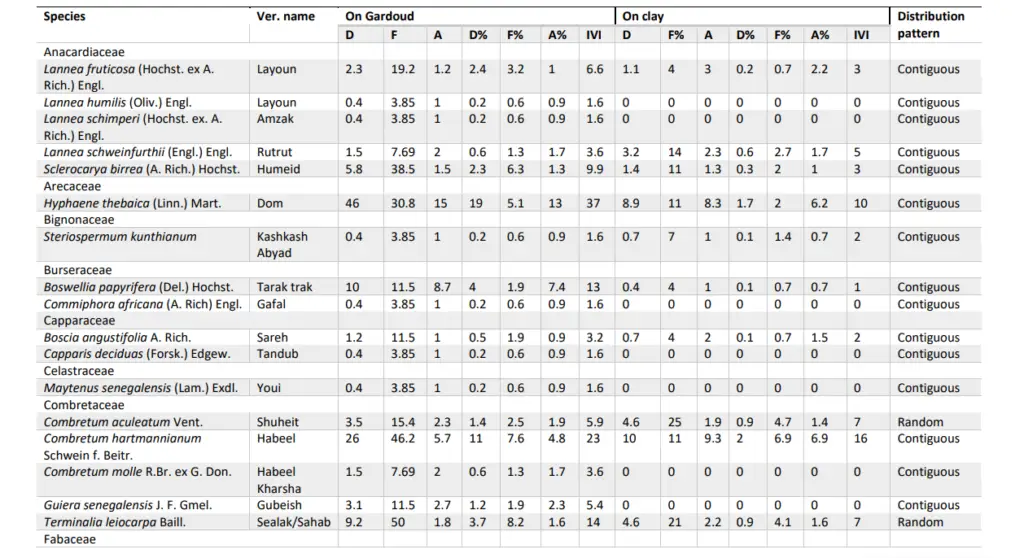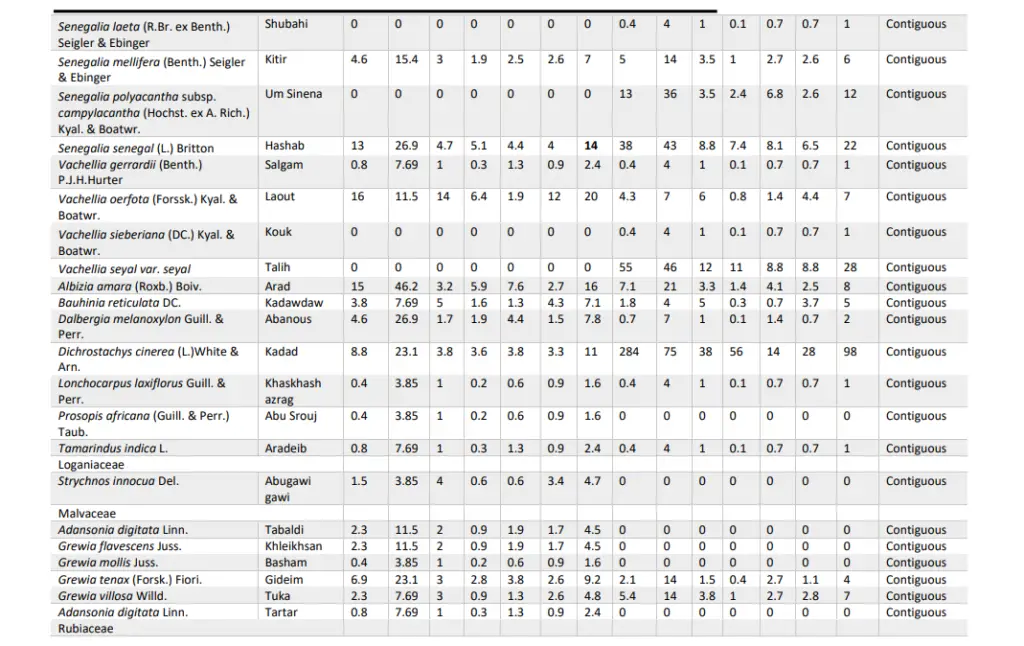
Flora Diversity, Phytosociology and Distribution Pattern of the Woody Vegetation and Its Relation to Soil Types, in Kalogi District, Nuba Mountains, Sudan
Ismail Mirghani Ismail
Forestry and Gum Arabic Research Centre, Agricultural Research Corporation, Khartoum, Sudan
| ARTICLE INFORMATION | ABSTRACT |
| Corresponding author: Ismail Mirghani Ismail E-mail: Ismail.mirghani@yahoo.com Keywords: Importance Value Index Contiguous Species Richness Species Evenness Gardoud Received: 04.10.2023 Received in revised form: 24.10.2023 Accepted: 28.10.2023 | The work documents the findings of ecological parameters, which have been carried out in the low-rainfall woodland savanna of the Nuba Mountains, Sudan. Filling the information gap on the woody vegetation along different habitats in Kalogi district. The vegetation sampling and data analysis were done following standard procedures. Forty-five plant species belonging to 29 genera and 14 families have been documented. The most common plant species based on the importance value index are Dichrostachys cinerea (IVI-98), Vachellia seyal (IVI-28), and Balanites aegyptiaca (IVI-25) respectively in dark cracking clay soil habitat. On the other hand, the most common species on GARDOUD soil habitats are Hyphaene thebaica (IVI-37), followed by Balanites aegyptiaca (IVI-35), Combretum hartmannianum (IVI-23), Vachellia oerfota (IVI-20) and Albizia amara (IVI-16) respectively. Fabaceae is found to be the most dominant family. The distribution pattern revealed that 95.6% of species showed contiguous distribution, while 4.4% were randomly distributed. GARDOUD habitats showed the highest values of species richness and diversity indices as flow: richness of 39 species, Shannon-Wiener’s (H’) (2.77), Pielou index (E) (.076), Simpson index (D) (0.9), Margalef index (M) (5.9). |
INTRODUCTION
Nuba Mountains describes a mountainous region approximately 10° to 12° N, and 29° to 31° E, surrounded by plains. It is also a region that, for the most part, lies in the federal state of South Kordofan (Ille, 2015). Nuba Mountains can be classified as one of the richest and most diversified regions in terms of vegetation cover components, beside Jebel Marra in Darfur, Jebel ElDair in North Kordofan, Ingassana Hills in the Blue Nile, and Red Sea Hills in the Red Sea.
Kalogi district is where is study is conducted and is located in Gadeer locality which is one of the 16 localities of South Kordofan State.
The study of plant communities and their classification is termed phytosociology (Mishra et al. 2012; Ahmad and Shaukat, 2012). Phytosociology is useful to describe the population dynamics of each plant species occurring in a particular community and to understand how they relate to the other species in the same community (Mishra et al. 2012).
The Convention on Biological Diversity (1992) defined Biodiversity as “the variability among living organisms from all sources including among other things, terrestrial, marine and other aquatic ecosystems, and the ecological complexes of which they are part; this includes diversity within species, between species, and of ecosystems.
Species richness refers to the number of species in a particular area, whereas species diversity refers to a combination of richness and relative abundance (Newton, 2007). A comprehensive review of the methods used for estimating both of these variables is provided by Magurran (2004).
Lack of information on both taxonomical and ecological regarding the woody vegetation of the Kalogi district, besides the climatic changes during the last decades, which may change the floristic composition, encouraged to conduct of this study.
The area is considered one of the most important sources of diversified timber and non-timber forest products to the Sudanese markets.
This study aimed to fill the information gap on the woody vegetation along different habitats in the Kalogi district. Furthermore, we expect to have more Comprehensive and detailed information about these native woody vegetation regarding floristic and ecological aspects.
MATERIAL AND METHODS
Study area
The study area is located in the Gadeer locality of Nuba Mountains, South Kordofan. the study area extends from Umdiheileeb village (11° 2’41.56″N, 30°59’7.03″ E) in the north to Morong village (10°33’29.60″N, 31° 5’36.12″ E) in South and from Tosi village (10°51’50.22″ N, 30°49’48.10″ E) in the western direction to Gadeer village (10°49’40.02″ N, 31° 7’51.11” E) in the east. The vegetation of the area of this study was classified according to (Harrison and Jackson, 1958) as special areas of low rainfall woodland savanna.
Data collection
Systematic sampling has been carried out with 56 circular plots of 01 ha. covering different sites during the period from Nov. to Dec. 2019. In each plot, all woody plants and individual numbers of each have been recorded. According to soil types, the vegetation of the study area was divided into two vegetation communities: vegetation of dark cracking clay soil and vegetation of GARDOUD soil.
Data analysis
Phytosociology analysis
Phytosociological analysis was conducted for the woody vegetation of the Kalogi district. The density, frequency, and abundance of each species were measured and values were converted to their relative values to obtain the Importance value index (IVI) (Curtis, 1959).
The distribution pattern of the woody species was calculated as abundance/frequency ratio (A/F) as suggested by Whitford (1949) as a measure of contiguousness. The ratio indicates regular ( 0.05) distributions (Curtis and Cottam, 1956).
Diversity indices
Species diversity, equitability, and concentration of dominance were computed by using Shannon-Weaver (1949), (Pielou, 1966), and Simpson indices (1949), respectively. Species richness was obtained as a number of species an calculated by Margalef’s Index (1968). Similarity between habitats was obtained by using the Jaccard index (Jaccard, 1912).
The past 3 packages have been used for data analysis to obtain alpha diversity indices and the Biodiversity Pro 2 package used for calculating the Jaccard index and the past 3 packages have been used for data analysis.
RESULTS AND DISCUSSION
Floristic composition
In this study, a total of 45 woody species belonging to 29 genera and 14 families were sampled. The most represented family was Fabaceae with 15 species followed by Malvaceae 6 and Anacardiaceae, and Combretaceae with 5 species for each. Fabaceae is considered one of the dominant and most important families in Sudan (Table 1), it is also recorded as a dominant family in different studies (Ismail and ElSheikh, 2016; Ismail, 2020a; Ismail, 2020b).
Phytosociology analysis
Density and frequency
A total of 38 tree species were sampled in garden soil habitats. The absolute density of total woody plant species in GARDOUD habitats was 248.1 stem/ha. The highest relative density was recorded by Hyphaene thebaica (19%) which is frequent in 30% of sampled plots and Balanites aegyptiaca (19%) which is frequent in 53.8% of sampled plots followed by Combretum hartmannianum (11%) which frequent in 46.2% of sampled plots (Table 1).
A total of 30 tree species were recorded from habitats of dark-cracking clay soil. The absolute density of total woody plant species in dark-cracking clay soil habitats was 510.1 stem/ha.
The highest relative density was recorded by Dichrostachys cinerea (56%) which is frequent in 75% of sampled plots followed by Vachellia seyal (11%) which frequent in 46% of sampled plots and Balanites aegyptiaca (7.9%) which frequent in 64% of sampled plots (Table 1).
Dominance
The most dominant species in dark cracking clay soil habitat was Dichrostachys cinerea with IVI (98), followed by Vachellia seyal (28), Balanites aegyptiaca (25), Senegalia senegal (22) and Combretum
hartmannianum (16) (Figure 2). While the dominant species in the GARDOUD soil habitat was Hyphaene thebaica with IVI (37), followed by Balanites aegyptiaca (35), Combretum hartmannianum (23), Vachellia oerfota (20) and Albizia amara (16) (Figure 3).
It’s clear that Dichrostachys cinerea dominated species with the highest value of IVI; this may be due to the suitability of dark cracking clay soil habitat to the requirements of this species, in addition to the fruits and leaves of this species is considered as one of the most important sources of fodder for animals during the dry season. This area where species is dominant is considered one of the most important routes of seasonal migration of animals that feed on its fruits, and therefore animals play an important role in spreading their seeds all over the area.
From the results we found that Balanites aegyptiaca and Combretum hartmannianum are listed as dominant species of both habitats, this assures its ability to live in diversified habitats.
Figure 2: Dominant woody species of GARDOUD soil.
Distribution pattern
Among the studied habitats, distribution pattern of all woody species was contiguous (95.6%) except Terminalia leiocarpa and Combretum aculeatum were random (4.4%) and no species showed a regular pattern. 15 (34.0%) of the species of contiguous pattern were distributed only in the GARDOUD soil habitat and 5 species (11.6%) were distributed only in dark cracking clay soil habitat, while 23 species (53.5%) of contiguous pattern and the two species of random pattern were distributed in both the two habitats (Table 1).
From the results, it’s clear that a contiguous distribution pattern was recorded for the majority of species followed by only two species that showed a random pattern. There was no record of a regular distribution pattern, this may attributed to the absence of severe competition among species; this agreed with the fact that stated by Odum (1971) contiguous pattern of distribution is common in nature, random distribution is found only in very uniform environment and regular distribution occurs where severe competition exists between individuals.
Diversity Analysis
In the study area, species richness and diversity were found higher in the GARDOUD soil habitat as compared to Dark dark-cracking clay soil habitat of the study area. GARDOUD soil habitat showed higher values in all diversity indices as follows, Shannon Weiner’s (H’) (2.77), Pielou index (E) (.076), Simpson index (D)
Figure 3: Dominant woody species of soil dark cracking clay habitats
(0.9), Margalef index (M) (5.9) and richness of 39 species (Figure 2); while habitat of Dark cracking clay soil showed lower values in all diversity indices as follow, Shannon-Wiener’s (H’) (1.76), Pielou index (E) (.0.52), Simpson index (D) (0.66), Margalef index (M) (3.99) and richness of 30 species (Figure 4).
The lowest values of diversity indices may be attributed to intensive human activities such as the continuous expansion of mechanized and shifting agricultural activities in highly fertile and productive dark-cracking clay soil; whereas GARDOUD soil rarely be cultivated by seasonal crops.
The values of diversity indices in dark cracking soil habitat were relatively low due to the dominance of Dichrostachys cinerea with the largest value of IVI, exceeding the values of all species studied, a similar case was stated by Ismail and Alawad (2017). The low evenness value indicates the dominance of the environment by a few species (Van Breugel et al. 2007).
Similarity
The similarity of species between the two studied habitats is illustrated in Figure 5. revealed that 53.3% of the woody species were shared between the two habitats. This may be due to the suitability of the habitats to the requirements of these species. Balanities aegyptiaca and Combretum hartmannianum can be considered as the most important species in the study area; especially because they showed dominance in both habitats.
Table 1: phytosociological parameters and distribution pattern of the studied species



Figure 4: Richness and diversity indices of the two studied habitats Figure
5: Dendrogram showing the percent of similarity between studied habitats.
CONCLUSION
The woody plants cover a diversity of the studied area and were represented by 45 plant species belonging to 29 genera under 14 families. While the dominant family Fabaceae is represented with 15 species, 7 families are monotypic. Dichrostachys cinerea showed the maximum IVI values at habitats of dark-cracking clay soil and the whole study area. The habitats of GARDOUD soil the more diverse than those of dark-cracking clay soil.
REFERENCE
Ahmad, M.; Shaukat, S.S.A. Textbook of Vegetation Ecology. Abrar Sons, Karachi, Pakistan, 2012, 302-305 pp. Convention on Biological Diversity. http://sedac.ciesin.org/entri/texts/biodiversity, 1992. htm (accessed on 22nd April 2008).
Curtis, J.T. The vegetation of Wisconsin. An ordination of plant Communities. University of Wisconsin Press, Madison Wisconsin. 1959.
Curtis, J.T.; Cottam, G. Plant Ecology Work Book. (A Labo¬ratory Field Reference Manual. Minnesota, Burgess Publishing, CO., 1956, 193.
Harrison, M.N.; J.K. Jackson. Ecological classification of the vegetation of the Sudan. Agricultural Publication Committee, Khartoum. 1958, 44 Pp.
Ille, E. An Annotated Bibliography of Social Research on the Nuba Mountains. Christian Michelsen Institute. N-5892 Bergen Norway, 2015.
Ismail, I.M.; ElSheikh, E.A. Floristic composition, Phytosociology and species diversity of Woody vegetation of Jebel AlGerri, Blue Nile State, Sudan. Journal of Natural Resources & Environmental Studies, 2016, 4 (2): 24-34.
Ismail, I.M. Changes in Ecological Parameter of Woody Vegetation along Altitudinal Gradient in Jebel El-Dair, North Kordofan, Sudan. Journal of Forest Research, 2020b, 9(2): 228.
Ismail, I.M. Phytosociology and Biodiversity Indices of the Woody Plants of Alfula Area, West Kordofan, Sudan. Agriculture and Forestry Journal. 2020a, 4 (1): 40-46.
Ismail, I.M.; Elawad, A.A. Changes in Plant Species Richness and Density along Altitudinal Gradient in Rashad and Alabassia Localities, South Kordofan, Sudan. Neelain Journal of Science and Technology. 2017 1 (1): 21.
Jaccard, P. The distribution of the flora in the alpine zone. New Phytologist. 1912, 11(2):37–50. Magurran, A.E. Measuring biological diversity. Malden, Blackwell. 2004. Margalef, D.R. Information theory in ecology. General System, 1958, 3: 36-71.
Mishra, N.K.; Singh, R.; Ojha, S.S. Phytosociological perspectives of representative herbaceous Genera of common occurrence belonging to family Asteraceae in Grassland ecosystem of Anpara region in District Sonebhadra (U.P.). Indian Journal of Life Sciences 2012, 2(1): 119- 122.
Newton, A.C. Forest Ecology and Conservation, A Handbook of Techniques. Techniques in Ecology and Conservation Series. Oxford University Press. 2007. Odum, E.P. Fundamentals of ecology, 3rd ed. Philadelphia: Saunders. 1971, 574 p.
Pielou, E. C. The measurement of diversity in different types of biological collections. Journal of Theoretical Biology. 1966, 13: 131-144.
Shannon, C.E.; Weaver, W. The Mathematical Theory of Communication. University of Illinois Press, Urbana, USA Simpson, E.H. 1949. Measurement of diversity. Nature. 1963, 163: 688.
Van Breugel, M.; Bongers, F.; Ramos, M.M. Species Dynamics during Early Secondary Forest Succession: Recruitment, Mortality and Species Turnover. BIOTROPICA. 2007, 35(5), 610–619.
Whitford, P.B. Distribution of woodland plants in relation to succession and clonal growth. Ecology. 1949, 30: 199-208.

